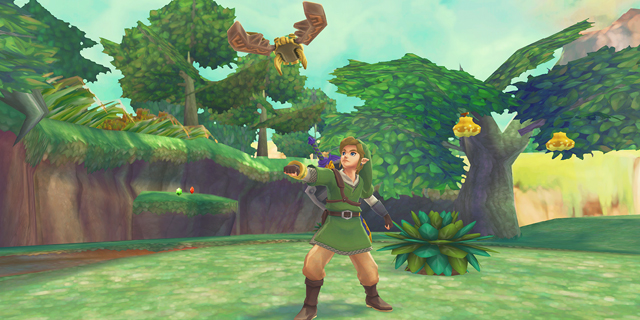
I love Legend of Zelda games. The exploration, the combat, and the reinvention of the cast at large that serve to suit the individual game rather than any grand over-arching story have made Zelda one of my favorite video game franchises. I loved pushing gravestones in the original, discovering the dark world in A Link to the Past, linking my adventures together in Oracle of Seasons and Oracle of Ages, directing the wind in Wind Waker and playing through the mansion in Twilight Princess.
I’m also a fan of traversing the larger games. Horse-riding in Ocarina of Time, train-riding in Spirit Tracks and especially sailing in Wind Waker were all great. Jumping from Skyloft and knowing that your bird will be there to catch you blows all of those things away. No matter how many times I did it, the sensation was wonderful. It throws you right into the Skyloft way of life, and really embodies who Link is and always has been: an adventurer who (if you play the way I do) has a gigantic grin on his face the majority of the time.
The Zelda franchise is 25 years old. That’s a lot of Master Swords, bows and arrows, puzzle-solving and fire dungeons to work through, but Skyward Sword manages to feel fresh. Sure, you’re still going to collect a slingshot in the Forest Temple and bombs in the Fire Temple, but your route there is different than it has ever been before. If Skyward Sword is most similar to any other Zelda game, it has to be Oracle of Ages. The primary emphasis this time around is definitely on puzzle-solving. I seldom entered a room and immediately though “Oh, I need the <thing> to do this – I’ll come back later,” but I thought “Huh, how am I going to solve this one” quite a bit.
Combat works much the same way. Wii MotionPlus is used to great effect in the swordplay, and combat feels more natural. I’ve never used a real sword before, but this combat is more involved. You’re not holding L to block and then pressing A to roll around and slice of a Darknut’s armor. You’re standing up, holding your sword in an attack position, waiting for your opening, and taking it. Or you’re lining something up and needing to thrust the nunchuk forward to block (which works a lot better here than it did in Twilight Princess). This is the combat that we all thought of when the Wii remote was first revealed: one-to-one motion controls that actually work, and make a game more fun that it would be without them. It’s just a shame that it took until the Wii’s successor was announced to get it.
Another great addition to the classic Zelda formula is the Adventurer’s Pouch. This pouch, like the wallet, quiver, and magic meter you’re already familiar with, can be upgraded to hold more items over time. The items you’ll carry around in it aren’t essential but make your trek through the various dungeons easier. This is where your bottles, bomb bag expansions, shields (sometimes wood is better than metal so you won’t be letting go of your old equipment when you upgrade) and medals will be stored. Medals function a bit like accessories from any RPG: you can equip a few and they have different beneficial effects, like upping the likelihood that defeated enemies will drop hearts or extra money.
So far, Skyward Sword sounds like the best Zelda game to date, and it still might be. There is room for improvement though, and it all comes from editing. Mandatory fetch quests are not fun. I don’t want to run the spoon back to the old lady so she can give me a Yoshi doll that I have to cart across the map to give to the little boy on the beach. It’s not fun, it’s not engaging and it doesn’t make me feel like a part of whatever world is being crafted. What does make me feel like a part of narrative is going out and doing things that make sense and are related to the task at hand. That means I’m okay with looking for bottles because combat gets tricky and I’d like extra bottles to store potions in, collecting crafting ingredients to take to the bazaar to get myself a stronger shield or sturdier net, and scouring temples for one more piece of heart because I could really use another full container. Optional quests are fine. I don’t hate the trading sequence from Link’s Awakening, because if I choose not to do I just don’t get the boomerang. That’s fine. Sure, it makes things easier, but if I don’t want to traipse all over creation, I don’t have to. In Skyward Sword I have to, because somebody somewhere decided that the game needed to be a few hours longer. People don’t care if a game is 25 hours instead of 35 if those 25 are full of fun things to do instead of retreading the same ground and picking up things that were inexplicably not present on your first trip.
Skyward Sword is the best Zelda game I have ever played. There just happens to be a lot of filler surrounding it. I don’t know who decided that Skyward Sword needed to be longer, but there are much better ways to add length than making me retrace my steps and re-fight the same bosses. It’s a great game full of life and polish, and the elements that keep it from being a perfect 5 stick out because everything else is executed so expertly.
Pros: Puzzle-heavy temples, great 1:1 swordplay, added RPG elements, jumping off Skyloft never gets old
Cons: Needless fetch quests and repeated boss fights serve only to lengthen the game and stick out for the filler they are



















